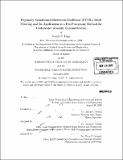Physically constrained maximum likelihood (PCML) mode filtering and its application as a pre-processing method for underwater acoustic communication
Author(s)
Papp, Joseph C
DownloadFull printable version (12.66Mb)
Other Contributors
Woods Hole Oceanographic Institution.
Advisor
James C. Preisig.
Terms of use
Metadata
Show full item recordAbstract
Mode filtering is most commonly implemented using the sampled mode shape or pseudoinverse algorithms. Buck et al [1] placed these techniques in the context of a broader maximum a posteriori (MAP) framework. However, the MAP algorithm requires that the signal and noise statistics be known a priori. Adaptive array processing algorithms are candidates for improving performance without the need for a priori signal and noise statistics. A variant of the physically constrained, maximum likelihood (PCML) algorithm [2] is developed for mode filtering that achieves the same performance as the MAP mode filter yet does not need a priori knowledge of the signal and noise statistics. The central innovation of this adaptive mode filter is that the received signal's sample covariance matrix, as estimated by the algorithm, is constrained to be that which can be physically realized given a modal propagation model and an appropriate noise model. The first simulation presented in this thesis models the acoustic pressure field as a complex Gaussian random vector and compares the performance of the pseudoinverse, reduced rank pseudoinverse, sampled mode shape, PCML minimum power distortionless response (MPDR), PCML-MAP, and MAP mode filters. The PCML-MAP filter performs as well as the MAP filter without the need for a priori data statistics. The PCML-MPDR filter performs nearly as well as the MAP filter as well, and avoids a sawtooth pattern that occurs with the reduced rank pseudoinverse filter. The second simulation presented models the underwater environment and broadband communication setup of the Shallow Water 2006 (SW06) experiment. (cont.) Data processing results are presented from the Shallow Water 2006 experiment, showing the reduced sensitivity of the PCML-MPDR filter to white noise compared with the reduced rank pseudoinverse filter. Lastly, a linear, decision-directed, RLS equalizer is used to combine the response of several modes and its performance is compared with an equalizer applied directly to the data received on each hydrophone.
Description
Thesis (S.M.)--Joint Program in Oceanography/Applied Ocean Science and Engineering (Massachusetts Institute of Technology, Dept. of Electrical Engineering and Computer Science; and the Woods Hole Oceanographic Institution), 2009. Cataloged from PDF version of thesis. Includes bibliographical references (p. 85-87).
Date issued
2009Department
Joint Program in Oceanography/Applied Ocean Science and Engineering; Woods Hole Oceanographic Institution; Massachusetts Institute of Technology. Department of Electrical Engineering and Computer SciencePublisher
Massachusetts Institute of Technology
Keywords
/Woods Hole Oceanographic Institution. Joint Program in Oceanography/Applied Ocean Science and Engineering., Electrical Engineering and Computer Science., Woods Hole Oceanographic Institution.